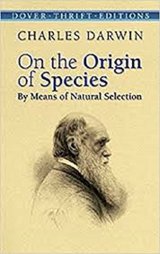On the Origin of Species By Means of Natural Selection Page #15
On the Origin of Species, published on 24 November 1859, is a work of scientific literature by Charles Darwin which is considered to be the foundation of evolutionary biology. Darwin's book introduced the scientific theory that populations evolve over the course of generations through a process of natural selection.
If the plants inhabiting a country and described in any Flora be divided into two equal masses, all those in the larger genera being placed on one side, and all those in the smaller genera on the other side, a somewhat larger number of the very common and much diffused or dominant species will be found on the side of the larger genera. This, again, might have been anticipated; for the mere fact of many species of the same genus inhabiting any country, shows that there is something in the organic or inorganic conditions of that country favourable to the genus; and, consequently, we might have expected to have found in the larger genera, or those including many species, a large proportional number of dominant species. But so many causes tend to obscure this result, that I am surprised that my tables show even a small majority on the side of the larger genera. I will here allude to only two causes of obscurity. Fresh-water and salt-loving plants have generally very wide ranges and are much diffused, but this seems to be connected with the nature of the stations inhabited by them, and has little or no relation to the size of the genera to which the species belong. Again, plants low in the scale of organisation are generally much more widely diffused than plants higher in the scale; and here again there is no close relation to the size of the genera. The cause of lowly-organised plants ranging widely will be discussed in our chapter on geographical distribution. From looking at species as only strongly-marked and well-defined varieties, I was led to anticipate that the species of the larger genera in each country would oftener present varieties, than the species of the smaller genera; for wherever many closely related species (i.e. species of the same genus) have been formed, many varieties or incipient species ought, as a general rule, to be now forming. Where many large trees grow, we expect to find saplings. Where many species of a genus have been formed through variation, circumstances have been favourable for variation; and hence we might expect that the circumstances would generally be still favourable to variation. On the other hand, if we look at each species as a special act of creation, there is no apparent reason why more varieties should occur in a group having many species, than in one having few. To test the truth of this anticipation I have arranged the plants of twelve countries, and the coleopterous insects of two districts, into two nearly equal masses, the species of the larger genera on one side, and those of the smaller genera on the other side, and it has invariably proved to be the case that a larger proportion of the species on the side of the larger genera present varieties, than on the side of the smaller genera. Moreover, the species of the large genera which present any varieties, invariably present a larger average number of varieties than do the species of the small genera. Both these results follow when another division is made, and when all the smallest genera, with from only one to four species, are absolutely excluded from the tables. These facts are of plain signification on the view that species are only strongly marked and permanent varieties; for wherever many species of the same genus have been formed, or where, if we may use the expression, the manufactory of species has been active, we ought generally to find the manufactory still in action, more especially as we have every reason to believe the process of manufacturing new species to be a slow one. And this certainly is the case, if varieties be looked at as incipient species; for my tables clearly show as a general rule that, wherever many species of a genus have been formed, the species of that genus present a number of varieties, that is of incipient species, beyond the average. It is not that all large genera are now varying much, and are thus increasing in the number of their species, or that no small genera are now varying and increasing; for if this had been so, it would have been fatal to my theory; inasmuch as geology plainly tells us that small genera have in the lapse of time often increased greatly in size; and that large genera have often come to their maxima, declined, and disappeared. All that we want to show is, that where many species of a genus have been formed, on an average many are still forming; and this holds good. There are other relations between the species of large genera and their recorded varieties which deserve notice. We have seen that there is no infallible criterion by which to distinguish species and well-marked varieties; and in those cases in which intermediate links have not been found between doubtful forms, naturalists are compelled to come to a determination by the amount of difference between them, judging by analogy whether or not the amount suffices to raise one or both to the rank of species. Hence the amount of difference is one very important criterion in settling whether two forms should be ranked as species or varieties. Now Fries has remarked in regard to plants, and Westwood in regard to insects, that in large genera the amount of difference between the species is often exceedingly small. I have endeavoured to test this numerically by averages, and, as far as my imperfect results go, they always confirm the view. I have also consulted some sagacious and most experienced observers, and, after deliberation, they concur in this view. In this respect, therefore, the species of the larger genera resemble varieties, more than do the species of the smaller genera. Or the case may be put in another way, and it may be said, that in the larger genera, in which a number of varieties or incipient species greater than the average are now manufacturing, many of the species already manufactured still to a certain extent resemble varieties, for they differ from each other by a less than usual amount of difference.
Translation
Translate and read this book in other languages:
Select another language:
- - Select -
- 简体中文 (Chinese - Simplified)
- 繁體中文 (Chinese - Traditional)
- Español (Spanish)
- Esperanto (Esperanto)
- 日本語 (Japanese)
- Português (Portuguese)
- Deutsch (German)
- العربية (Arabic)
- Français (French)
- Русский (Russian)
- ಕನ್ನಡ (Kannada)
- 한국어 (Korean)
- עברית (Hebrew)
- Gaeilge (Irish)
- Українська (Ukrainian)
- اردو (Urdu)
- Magyar (Hungarian)
- मानक हिन्दी (Hindi)
- Indonesia (Indonesian)
- Italiano (Italian)
- தமிழ் (Tamil)
- Türkçe (Turkish)
- తెలుగు (Telugu)
- ภาษาไทย (Thai)
- Tiếng Việt (Vietnamese)
- Čeština (Czech)
- Polski (Polish)
- Bahasa Indonesia (Indonesian)
- Românește (Romanian)
- Nederlands (Dutch)
- Ελληνικά (Greek)
- Latinum (Latin)
- Svenska (Swedish)
- Dansk (Danish)
- Suomi (Finnish)
- فارسی (Persian)
- ייִדיש (Yiddish)
- հայերեն (Armenian)
- Norsk (Norwegian)
- English (English)
Citation
Use the citation below to add this book to your bibliography:
Style:MLAChicagoAPA
"On the Origin of Species By Means of Natural Selection Books." Literature.com. STANDS4 LLC, 2025. Web. 11 Jan. 2025. <https://www.literature.com/book/on_the_origin_of_species_by_means_of_natural_selection_323>.




Discuss this On the Origin of Species By Means of Natural Selection book with the community:
Report Comment
We're doing our best to make sure our content is useful, accurate and safe.
If by any chance you spot an inappropriate comment while navigating through our website please use this form to let us know, and we'll take care of it shortly.
Attachment
You need to be logged in to favorite.
Log In